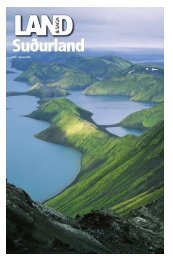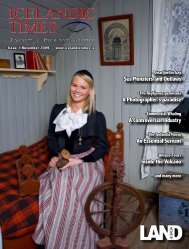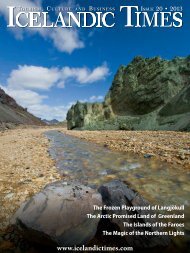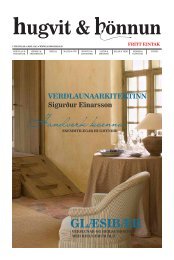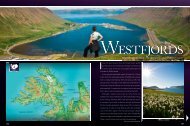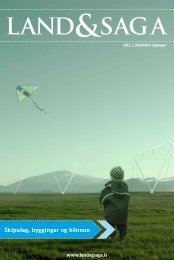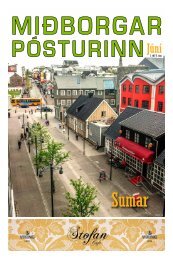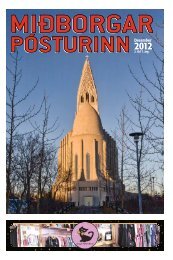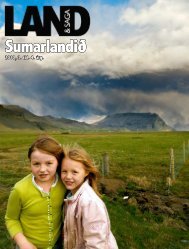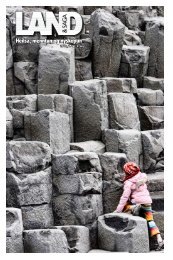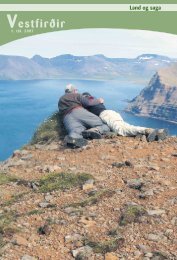ICELANDIC TIMES - Land og saga
ICELANDIC TIMES - Land og saga
ICELANDIC TIMES - Land og saga
Create successful ePaper yourself
Turn your PDF publications into a flip-book with our unique Google optimized e-Paper software.
The Akranes Museum Area<br />
– Interesting and Diverse Museums<br />
Just above the town of Akranes<br />
you can find various old and new<br />
buildings as well as some old<br />
boats. This is the “Museum Area”<br />
where not only can you learn<br />
some interesting facts about the<br />
life in Akranes throughout the<br />
centuries by experiencing all<br />
sorts of historic items, but also<br />
learn to know different minerals<br />
or everything about Iceland’s<br />
achievements in the Olympics.<br />
You will probably be able to lose<br />
yourself in these museums and<br />
spend a whole day examining<br />
every small object, taking a break<br />
to enjoy a nice cup of coffee in the<br />
Garðakaffi coffeeshop.<br />
The Museum Area is situated in<br />
the grounds of the ancient manor<br />
of Garðar. Garðar had a church and<br />
a parsonage from the early days of<br />
christian Iceland until the late 19th<br />
century. The Akranes Folk Museum<br />
was established there in 1959, so<br />
it has recently celebrated its 50th<br />
anniversary. In the year 2000 a new<br />
building, The Museum Hall was built,<br />
in which two new museums were<br />
established, The Mineral Kingdom<br />
and Sports in Iceland, and the<br />
Museum Area became a reality. In<br />
the museum hall there is also an extra<br />
exhibition room dedicated to evershifting<br />
exhibitions. In addition to the<br />
museums you will find five old houses<br />
in the area as well as many old boats.<br />
“The area is quite big and extensive,<br />
as this has become an established<br />
museum area which grows every<br />
year,” says Jón Allansson, curator at<br />
the Akranes Folk Museum. “It’s not<br />
only ideal for people seeking a proper<br />
museum experience, but also for those<br />
who want to make a nice day out if it;<br />
see the museums, have some coffee<br />
and cake and take a stroll around the<br />
area.”<br />
The Folk Museum<br />
The Folk Museum presents the history<br />
and life of Akranes and the district of<br />
Hvalfjörður. The museum preserves a<br />
comprehensive collection of exhibits<br />
that bear witness to days long gone,<br />
relating to farming, housekeeping and<br />
the social conditions in the area.<br />
Jón says a lot of items come to<br />
mind when asked to name the most<br />
precious ones. “The ship Sigurfari<br />
has to be considered one of our most<br />
precious objects. In fact it’s the only<br />
preserved ship of this kind from the<br />
first years of decked fishing ships in<br />
Iceland, made in 1885.”<br />
The oldest items in the Folk museum<br />
date from the tenth century but the<br />
youngest are only five or six years<br />
old. The former are ancient lanterns,<br />
Interesting and Diverse Museums<br />
found during archeol<strong>og</strong>ical digs, but<br />
the latter are computers and mobile<br />
phones. “It might sound funny, but<br />
with technol<strong>og</strong>y developing so fast<br />
in the Western world we can already<br />
laugh at ten years old mobile phones<br />
and find them fit for a museum display<br />
case,” says Jón.<br />
The Museum Hall<br />
The first exhibition to mention in the<br />
Museum Hall is The Mineral Kingdom.<br />
It is especially interesting these days<br />
as the eruption in Eyjafjallajökull is<br />
a reminder of the strong forces of<br />
nature, creating new lava fields. It<br />
has the biggest collection of Icelandic<br />
rocks under one roof in Iceland<br />
according to Alma Auðunsdóttir<br />
who works for the Museum Area.<br />
“The mineral specimen derive from<br />
all over Iceland and some of them are<br />
cut and polished to give a different<br />
perspective,” says Alma. Among the<br />
minerals you can also find a good<br />
collection of ancient fossils. You can<br />
even take many of them in your hand<br />
to feel their weight and texture.<br />
Inside The Mineral Kingdom there<br />
is an exhibition dedicated to the<br />
making of the tunnel under the fjord<br />
of Hvalfjörður which opened in 1998.<br />
The tunnel is one of a kind in Iceland,<br />
being the only undersea tunnel. “The<br />
exhibition includes a model of the<br />
tunnel and its position under the<br />
sea, as it reaches astonishingly deep.<br />
There are also examples of hammerdrills<br />
and minerals alongside many<br />
phot<strong>og</strong>raphs from the work in<br />
pr<strong>og</strong>ress, drill cores and interesting<br />
rocks and minerals from the tunnel,”<br />
says Alma.<br />
You will also find a lively exhibition<br />
called Sports in Iceland featuring the<br />
history of sports in Iceland. All sports<br />
practised in Iceland are introduced<br />
and numerous exhibits connected<br />
with sports are on display, such as<br />
phot<strong>og</strong>raphs, equipment of various<br />
kinds, flags, pennants, trophies and<br />
other memorabilia associated with<br />
sports. A part of this exhibition is<br />
dedicated to sports in Akranes, the<br />
town being renowned for its sports<br />
enthusiasm.<br />
In the extra exhibition room in the<br />
museum hall you will find quite<br />
an interesting exhibition about the<br />
Icelanders who emigrated to North-<br />
America in the late 19th century. “The<br />
exhibition especially focuses on the<br />
tale of a boy who went from Akranes<br />
at the age of 12 to Canada. On the<br />
way he got lost and was thought to be<br />
dead. But 12 years later he knocks on<br />
his mother’s door in Akranes, a fine<br />
young man. He had got separated<br />
from his relatives but had found some<br />
other people he knew and came into<br />
the possession of a piece of land in<br />
Canada. But he always wanted to go<br />
back to Iceland and live there so he<br />
ended up in Akranes where he started<br />
a family,” says Alma.<br />
Boats and houses<br />
Various boats and five old houses are<br />
situated in the Museum Area, two of<br />
the houses being on display. In recent<br />
years old houses connected with the<br />
history of Akranes have been moved<br />
to the Museum Area and renovated<br />
in order to keep the past alive. But<br />
one of the old houses still stands<br />
in its original location. The Garðar<br />
house was built in 1876 and was the<br />
first concrete dwelling of its kind<br />
to be built anywhere in the Nordic<br />
countries. Firstly, it was built as a<br />
parsonage and shows in a very real<br />
way an Icelandic upper-class home,<br />
typical for a pastor’s household in the<br />
19th century.<br />
Neðri-Sýrupartur, which is the other<br />
house on display, was built in 1875 and<br />
is the oldest preserved house made of<br />
timber in Akranes. Formerly situated<br />
close to the Akranes lighthouse, it<br />
represents the typical home of a<br />
fisherman’s family in the old days.<br />
The museum’s largest artefacts<br />
constitute its expansive collection of<br />
ships and boats of various sizes and<br />
shapes. Possibly the most notable<br />
item on display at the museum is<br />
the aforementioned 86-tonne twomastered<br />
ketch Sigurfari, built out of<br />
oak in 1885. It was used for handline<br />
fishing in Icelandic waters until 1919.<br />
(Sigurfari needs to be restored and<br />
therefore it is no longer possible to step<br />
on board and enjoy the view from the<br />
deck, but the museum unfortunately<br />
lacks resources to renovate the ship.)<br />
Next to Sigurfari is also a pier where<br />
various small boats are lined up.<br />
These museums are somewhat<br />
different in nature but surely form<br />
a unity in their connection with<br />
Akranes and the life in the area. The<br />
museums themselves also provide<br />
guests with lively events. Next June,<br />
for example, a group of blacksmiths<br />
both Icelandic and foreign, will make<br />
items similiar to those on display in<br />
the Folk Museum. There will also be<br />
held a market day in the museum<br />
area in June, where various handicraft<br />
artists will offer their work on sale.<br />
It just might be an ideal day of culture<br />
to go with your family or friends to<br />
the museum area in the summer, have<br />
lunch at Garðakaffi and then get a<br />
guided tour to the museums at one<br />
o’clock.<br />
More information is available on<br />
museum.is<br />
26 27



